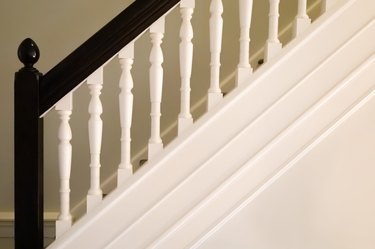
People make strange home decor decisions, like hanging loud wallpaper in a bedroom, laying carpet in moist places where it doesn't belong, and painting over vintage hardwood banisters. It's far easier to repaper the bedroom or remove moldy carpeting than it is to restore a banister, however, so if that's what you're about to do, get ready to put in a considerable amount of time and effort.
Getting old paint and varnish off a banister is a multistep procedure because the contours of the wood turnings won't allow you to do the job by scraping alone. You'll probably need to use a chemical stripper or heat gun to remove the bulk of the finish and sand off the rest. However, a third intermediate step can make the sanding part easier and produce better final results, and that's to use a strong solvent and abrasive pad to remove the residue left by the stripper. If you opt for this step, get out your respirator and open the windows because you're in for a smelly time.
Video of the Day
Video of the Day
Things You'll Need
Paintbrush
Paint scraper
Respirator
Sandpaper
Rotary tool
How to Remove Varnish and Paint From a Wooden Banister
Step 1: Strip the Bulk of the Finish
Chemical strippers vary in strength and toxicity. If you just need to remove a single coat of varnish, a citrus-based stripper will probably do the job while posing less of a safety hazard than a stronger one, but if you have several coats of paint to remove, go for the stronger product. Fortunately, it's easy to find a strong stripper that doesn't contain methylene chloride, so you should be able to avoid this noxious chemical. You might want to keep a heat gun handy to soften paint in crevices where chemical strippers can't easily reach.
Cover the floor, apply the stripper liberally using a paintbrush, and wait for the paint to bubble up before scraping it off with a paint scraper. You'll probably have to wait longer if you use a weak stripper, and you may have to add more to prevent the product from drying out. You can also soften the paint on turnings with the heat gun but keep the gun moving to avoid scorching the wood.
Step 2: Remove the Residue
After you're finished with the stripper, there is going to be a fair amount of paint residue left in crevices and corners not to mention the residue from the stripper itself. Instead of washing this off with a water solution (which raises the wood grain) and proceeding directly to sanding, get a can of lacquer thinner and a package of extra-fine steel wool, put on your respirator, and clean it off.
Put some lacquer thinner in a bowl, immerse the steel wool, and then scrub away. Lacquer thinner is a powerful solvent that will cut through stubborn residue, and it will also remove stripper residue without raising the wood grain. The steel wool is abrasive enough to remove material from small crevices, and it won't scratch the wood. Be careful because lacquer thinner is extremely flammable and it should never be exposed to sparks or open flames.
Step 3: Sand the Wood
Now, you're ready to sand. If you skipped the second step, you'll probably need to start the job with an orbital sander and 100-grit sandpaper. If you cleaned off the residue, you can use slightly finer 120-grit paper, which will minimize the scratch marks you have to sand out with finer paper. To get a really fine finish, do a final pass with 150-grit paper and sand the handrail by hand, going along the grain of the wood.
The crevices in turned spindles and in other places will probably be darker than the rest of the banister even if you sand them by hand with strips of sandpaper. That's normal, but you may be able to lighten them somewhat by going deep with a rotary tool and a sanding or grinding accessory but go lightly to avoid reshaping the wood. After sanding is completed, wipe down the banister with a damp rag prior to refinishing.